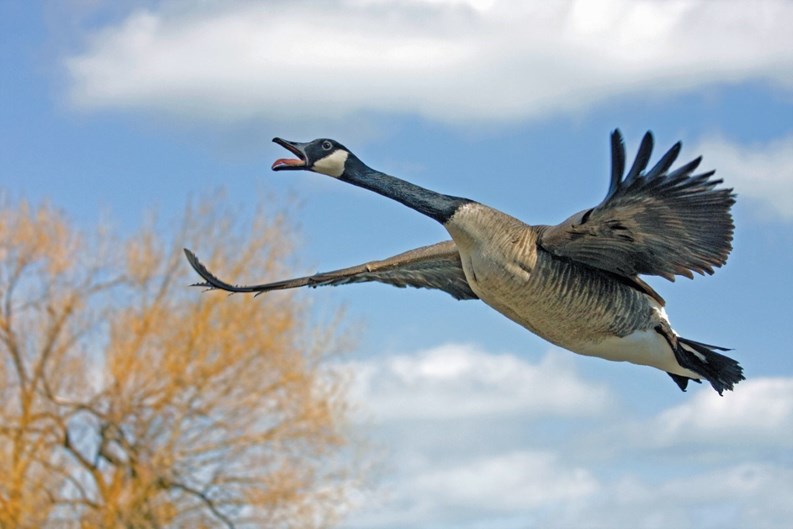These 12- to 15-pound birds were once migratory animals, but they lost that instinct when they were employed as live decoys by hunters. In the 1930s, live decoys were outlawed and the captive geese were turned loose, multiplying exponentially ever since.
These resident geese can now be found eating loads of cultivated grass, loitering around condominiums and leaving droppings everywhere. With an exploding population, they have become a general nuisance, and if a flock is large enough it can even contaminate water supplies.
Like homeowners weary of guests that stay too long, condos are looking for ways to move the geese off the property.
But, like with removing guests, condos face an uphill battle “because a lot of the things that are attractive to humans are attractive to geese,” says H. Heusmann, waterfowl biologist with the Massachusetts Division of Fisheries and Wildlife.
Amenities that geese like, says Heusmann, include landscaped ponds (great for swimming and protection from predators) and short, manicured lawns (great for grazing).
The trick to getting rid of the geese requires making the condo’s features less attractive to the fowl and adopting hard-nosed tactics to make their life unpleasant, says Heusmann. “You have to want to get rid of the geese more than they want to stay.”
Evicting the Geese
The first step in making the condo less hospitable to geese is to stop feeding them, no matter how “cute” they may be to some misguided residents. “In many cases, the original problem was traced back to the fact they (geese) were fed (by people),” says Heusmann. “You have to eliminate the feeding. You can’t be attracting them on one hand and chasing them away on the other hand,” he says. To be effective, Heusmann recommends that condos outlaw goose feeding and institute a system of fines for any resident caught flaunting the ban.
Employed at the same time as a cessation of feeding are a number of harassing tactics, varying in their intensity. The principle that makes harassment successful, says Heusmann, is, “If they (geese) have to expend more energy avoiding you than they're getting from the property (in food), they can’t stay there.”
Geese don’t like unusual noises or sights, so many condos have put out shiny or noisy objects like flags, strips of flashy metal or noisemakers to scare the creatures. Condos with small ponds have drafted hobbyists who use their radio-controlled boats to chase the geese around the water.
Another way to make geese uncomfortable in the water is to run twine or wire grid lines a few inches above the water’s surface, which makes it difficult for them to take off. “Unlike ducks, which just jump up in the air and take off, geese need a running start to take off, either on land or on water,” says Heusmann.
On land, trained dogs (typically border collies) have also been employed to harass geese. These dogs can have a rollicking good time keeping the geese moving and uncomfortable for hours. All of the scare tactics share a common failing – that the geese can adapt or become accustomed to them. Decoy coyotes, for instance, can lose their effectiveness if they aren’t moved around consistently. “Geese can learn that they’re not animals,” says Heusmann.
As for trained dogs, Heusmann says, “geese have learned what time the dogs work,” and return to the property after the dogs’ shifts are over.
Geese Repellent
Another way to drive geese off the property involves geese repellents, like FlightControl Plus. This EPA-approved repellent is applied to the condo’s turf, which geese eat and then get an upset stomach. The repellent also contains a compound that absorbs ultra-violet light, which only geese can see. When geese later see the repellent-treated grass, they associate it with sickness andmove on, seeking food that doesn’t make them ill.
While repellents can work, they can be labor-intensive to use, says Marion Larson, information and education biologist with the Massachusetts Division of Fisheries and Wildlife. Because rain washes away the repellent, “you have to go out there every time it rains (for re-application). If you have a whole lot of green grass, acres of green grass, you’ve got all of that to cover,” she says.
Addling Eggs
Another way to keep the number of geese down is disrupt their breeding cycle, typically by “addling” eggs, or smearing them with corn oil to prevent hatching. This method is time-consuming, as the nest must be located and eggs treated.
Further complicating the procedure is that permits are required to addle eggs in many New England states, including Massachusetts. Condo boards need to check with their state wildlife department to find out if theyneed permission before proceeding.
Hunting is another method of directly reducing the goose population on the property. Hunting seasons for geese are limited in all New England states, and many community associations have houses too close together to permit safe hunting. But, Heusmann notes, “If you can chase the geese out of your condo during the hunting season and they go to some place where they can be hunted, you can eliminate some of those geese.”
Condos that border fields or larger golf courses often have enough room so that geese can be hunted safely by well-trained sportsmen, says Heusmann. Again, he says that condos need to check with their respective states and localities to find out specifics of their state geese-hunting season and laws for discharging firearms.
Fencing Them Off
Barriers, or fencing, can also be used to encourage geese to move off a condo’s property, says Larson. Because geese cannot fly during the molting season, from mid-June to early-August, they need to be around water – which provides a haven from predators for them and their chicks, says Larson. Geese also like short grass, both to graze on and because they can see predators from far away.
Putting a three-foot-high fence between the pond and short grass can convince geese that accommodations are not up to snuff, says Larson, “We advise putting a fence around your pond. The geese will realize it’s not a good place to raise their young because when they molt they can’t get to the grass because the fence is in the way,” she says.
Fencing can also be used as a partial solution if it’s determined that the geese are too difficult to drive off, and the condo would settle for just keeping the goose droppings off its sidewalks, says Heusmann. “If you’ve determined that you can’t get rid of the geese but just want to keep them off of certain areas, you may say, ‘All right, we’re going to keep the geese away from the walkway to the parking lot by fencing.”
There are a number of tried and true methods to drive the geese off your condominium property before driving your management and residents crazy.
Jim Douglass is the managing editor of New England Condominium magazine.







Leave a Comment